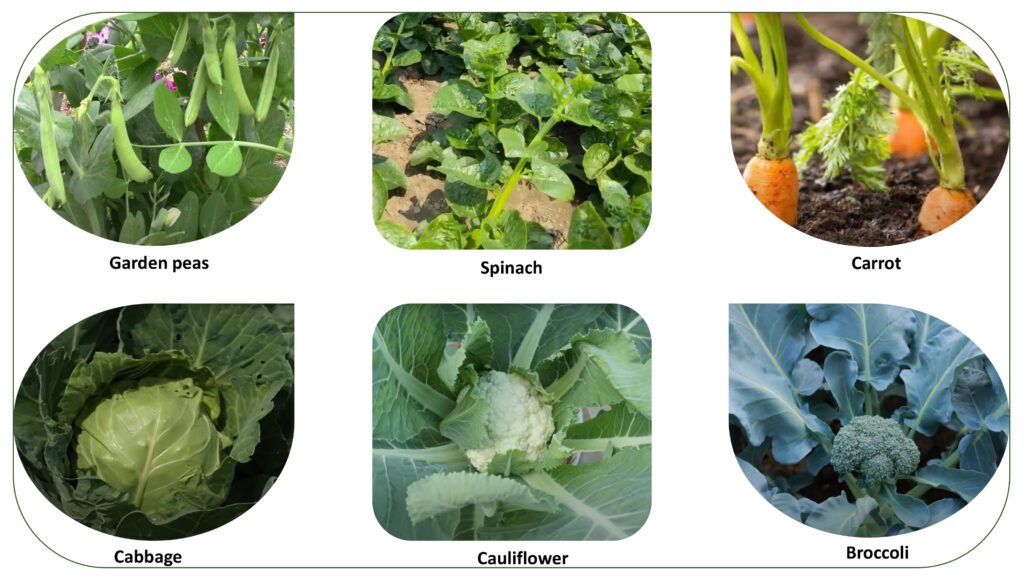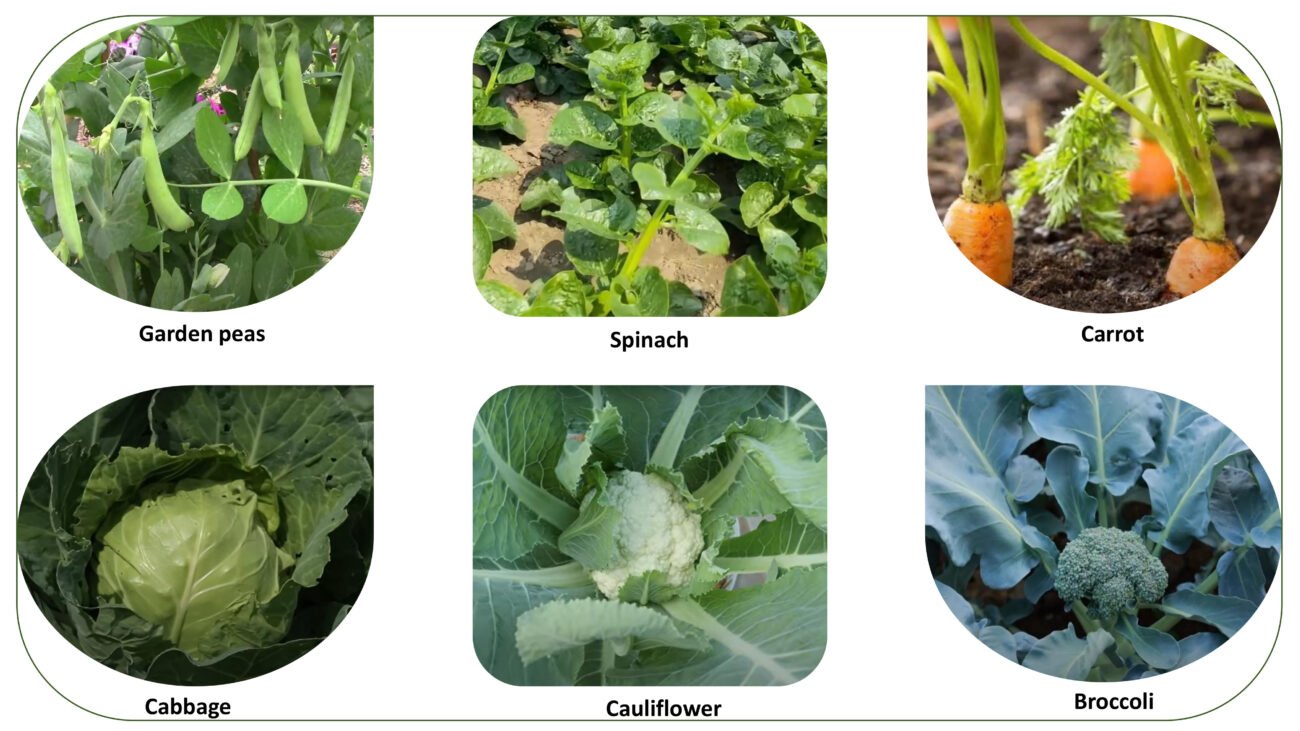Introduction
India is blessed with three distinct seasons, namely rainy, winter, and summer, making it suitable for cultivating Kharif, Rabi, and Summer crops. Each crop has its own climatic preference: some thrive in hot and humid conditions, others in cool weather, and still others in warm, sunny environments.
October marks the onset of the winter season, when many farmers begin sowing winter crops in the last week of October or the first week of November. If you visit a local market during this time, you will notice a fresh variety of vegetables appearing with the season. For instance, vegetables like garden peas, broccoli, cauliflower, cabbage, and spinach are typically seen only in winter, while tomatoes, cucumbers, and peppers are available year-round, and crops like gourds and French beans flourish during the rainy season. Did you think Why is it like that? The scientific reason is that some require long or short days and cool or hot weather.
Why does this happen? The scientific reason lies in the specific requirements of each crop. Some vegetables grow best under long days and cool weather, while others require short days and hot weather to develop properly. This is why certain vegetables, like spinach, peas, cauliflower, and cabbage, are naturally suited to the cooler months.
For home gardeners, especially those with limited space, this seasonal shift is the perfect opportunity to start a terrace garden. By choosing the right winter vegetables, you can enjoy a fresh, chemical-free harvest right at home throughout the season.
What Is a Terrace Garden?
A garden on a terrace is typically situated in a house with only a small garden space and is constructed on a terrace, roof, or courtyard. These terrace gardens are especially common in urban areas.
Selection of Site
Choose sunny spots with ample sunshine and water to build your roof or terrace garden. You can also choose veranda and the window sills for pot planting.
Tools required
Hand hoe, rake, planting hose, Hand sprayer, jute stakes, pots & quality plants, containers, soil
curing, strong organic sense, sand, Neem kernel seed extract, Neem oil, bamboo sticks, jute lines, pots.
Soil: Use well drained nutrient rich soil. Mix the garden soil, sand and vermicompost in 1:1:1 ratio. You can also use cocopeat as an alternative media.
Further reading: https://doi.org/10.1080/19315260801934266
Winter vegetables to grow terrace gardening
- Spinach – fast-growing leafy green, thrives in cool temperatures.
- Carrots -sweet flavor develops in colder weather.
- Radish– quick harvest (3–4 weeks), ideal for beginners.
- Beetroot – nutritious roots and edible greens.
- Lettuce -multiple varieties, perfect for terrace/balcony gardens.
- Cabbage– hardy winter crop, needs space and nutrient-rich soil.
- Cauliflower– popular winter veggie, requires consistent care.
- Peas-climbing plant, improves soil nitrogen content.
- Turnip-dual benefit of roots and leafy greens.
- Broccoli– nutrient-rich, cold-loving plant.

Further reading: https://www.abrinternationaljournal.org/articles/a-review-nutritional-value-of-winter-vegetables.pdf
How to start:
Fill the pots or polybags with soil mixture/ cocopeat. Sow the seeds in filled pots/ polybags/ containers and gently tap on them. The pots should be irrigated immediately after sowing. A dry grass or paw sheet is stretched across the soil and discarded later, before the seedlings emerge. Some of the plants have a month’s sowing fit for transplantation.
Nowadays, the plug trays are also available with a drainage hole measuring 2-3 “long for sowing the seeds. Half of the pipe should be filled with compost, and one seed is planted on each pipe and covered with compost for the remaining segment. when the seedlings are ready for transplanting, then, seedlings must be transplanted to big pots/ containers/polythene bags.
Cultural practices:
Nutrient management: Application at monthly intervals should be Vermicompost@100 g/plant. It can also be sufficient to add decomposed kitchen waste.
Water management: Watering will usually be performed as appropriate. Avoid overwatering during the winter season.
Weed control:
Hand hoeing and spinning tend to improve good plant growth in aeration at the root zone. In leafy
plants like amaranthus, spinach, fenugreek, coriander, etc., weeds should be gently removed.
Pest and disease management: Spray neem oil with 2 ml/L of water and a sticking agent of 2 ml/L of water, and soap, to kill the larvae contained on fruit and vegetables. For damping mitigation, irrigation will be avoided.
Harvesting:
When young, leafy vegetables should be harvested regularly.
Tips for Successful Winter Gardening in October
- Choose sunny spots
- Use well-drained, nutrient-rich soil.
- Regular watering but avoid waterlogging.
- Use mulch to protect roots from cold.
- Terrace gardeners: Use grow bags/containers with good drainage.
Common Mistakes to Avoid
- Planting summer vegetables in winter.
- Overwatering during cool weather.
- Not protecting plants from frost (in colder regions).
- Skipping organic manures or compost.
Conclusion
Winter gardening offers a profitable and sustainable way to enjoy fresh, nutrient-dense vegetables at home. The cool season provides perfect conditions for crops like spinach, peas, carrots, broccoli, and cabbage to thrive, making October the best time to start your terrace garden. With containers, nutrient-rich soil, and consistent care, even urban households with limited space can grow a variety of winter vegetables. By applying organic manure, watering properly, weeding, and using natural pest control methods, a healthy, chemical-free harvest can be obtained.
When you avoid common mistakes, such as planting summer vegetables in winter, overwatering, or neglecting sunlight and frost protection, you can increase your chances of success. A well-maintained terrace garden not only provides fresh produce but also boosts biodiversity, well-being, reduces reliance on market vegetables, and turns your living space into an aesthetic, productive, and eco-friendly corner throughout the season.
Trending blog: https://whereagroforestrymeetsagriculture.com/organic-vs-natural-farming-what-are-the-differences-and-which-is-better/
FAQs
Which vegetables can be grown in a terrace garden?
All the annual vegetables, including tomato, beans, root crops, chili, cole crops, and leafy vegetables, can be grown in a terrace garden.
Which vegetable is best to grow in winter?
Spinach – fast-growing leafy green, thrives in cool temperatures; Carrots -sweet flavor develops in colder weather; Radish– quick harvest (3–4 weeks), ideal for beginners; Beetroot – nutritious roots and edible greens; Lettuce -multiple varieties, perfect for terrace/balcony gardens; Cabbage– hardy winter crop, needs space and nutrient-rich soil; Cauliflower– popular winter veggie, requires consistent care; Peas-climbing plant, improves soil nitrogen content; Turnip-dual benefit of roots and leafy greens; Broccoli– nutrient-rich, cold-loving plant.
What is a terrace garden, and why is it ideal for winter vegetables?
A terrace garden is a garden created on a rooftop, balcony, or courtyard, making it perfect for urban homes with limited space. It allows you to grow seasonal vegetables like spinach, carrots, peas, and lettuce right at home during winter.
What vegetables should be grown in particular months?
January: Brinjal, Chili, Bitter gourd, Tomatoes, pumpkin, Radishes, Greens.
February: Brinjal, Tomato, Chili, Bitter gourd, Bhindi, Cluster bean, Ridge gourd, Greens.
March: Bhindi, Bitter gourd, Tomatoes, Ridge gourd.
April: Cluster bean, Bhindi, Cowpea
May: Brinjal, Tomatoes, Cluster bean.
June: Brinjal, Tomato, Pumpkin, Spinach, Bhindi, French bean, Field bean.
July: Chili, All gourds, Pumpkin, Ridge gourd, Bhindi, Cluster bean, Tomatoes.
August: Ridge gourd, Bitter gourd, Chili, Bhindi. September: Brinjal,
Ridge gourd, Pumpkin, Tomato.
October: Radish, Carrot, Beetroot, Potato, Cabbage, Cauliflower, Spinach, Amaranthus, Mustard, Garden pea.
November: Radish, Carrot, Beetroot, Potato, Cabbage, Cauliflower, Spinach, Amaranthus, Mustard, Garden pea.
December: Brinjal, Tomatoes, Pumpkin, Radish, Chili, and other vegetables are grown.
Where can we do roof gardening?
Apartments, single-storey houses, office premises, storage warehouses, and even set up a few factories.
What type of soil should I use for winter terrace gardening?
Use a well-drained, nutrient-rich soil mix in a ratio of 1:1:1 (garden soil, sand, and vermicompost). Alternatively, cocopeat can be used as a lightweight growing medium for containers.
Which are the best vegetables to grow in October on a terrace?
Some of the easiest and most rewarding winter vegetables include spinach, carrots, radish, beetroot, lettuce, cabbage, cauliflower, peas, turnip, and broccoli. These crops thrive in cool weather and provide a steady homegrown harvest.
How do I manage pests and diseases in my terrace garden naturally?
You can control pests by spraying neem oil (2 ml per liter of water with a sticking agent like soap solution). Regular weeding, proper watering, and using organic compost also keep plants healthy and reduce disease risks.

